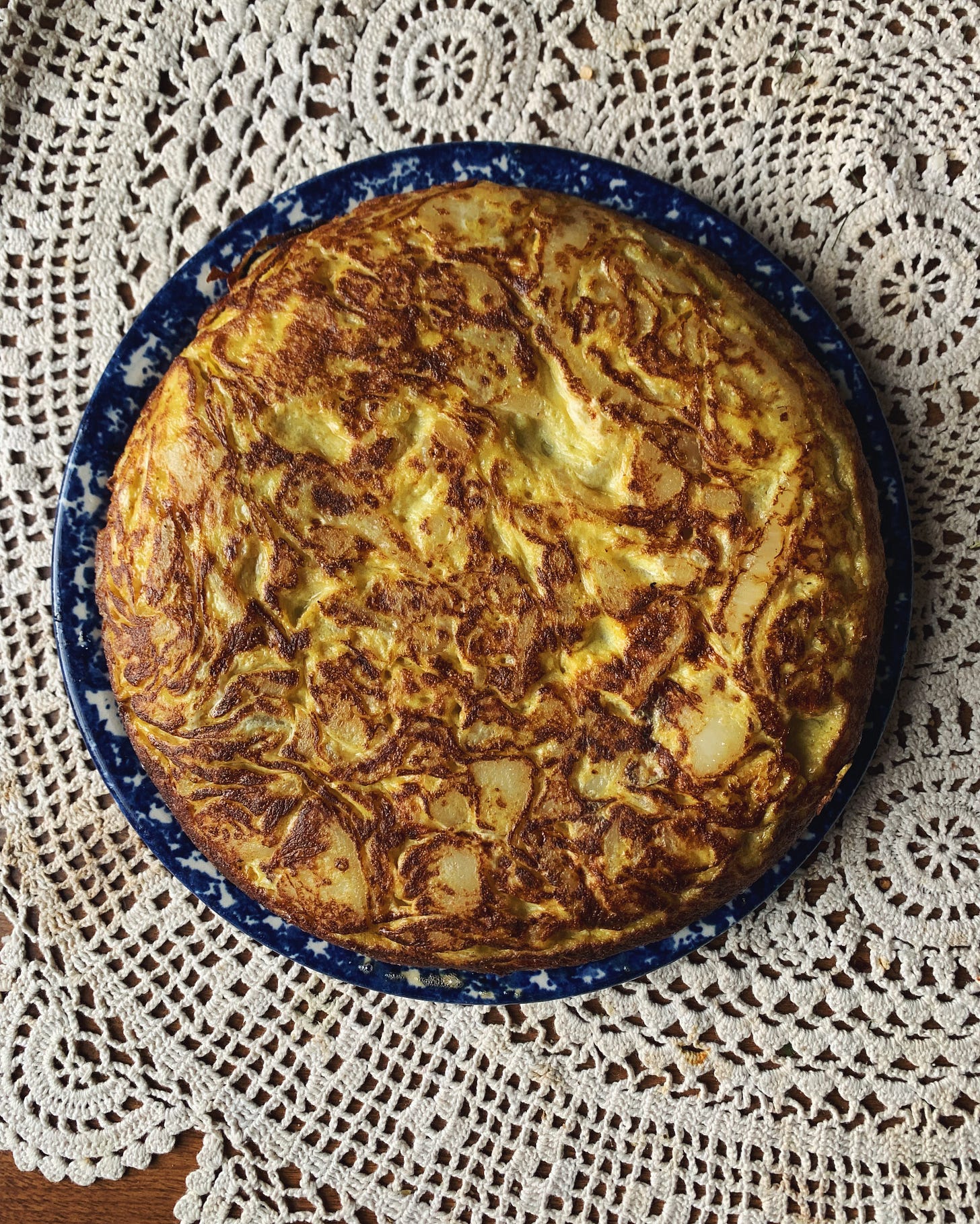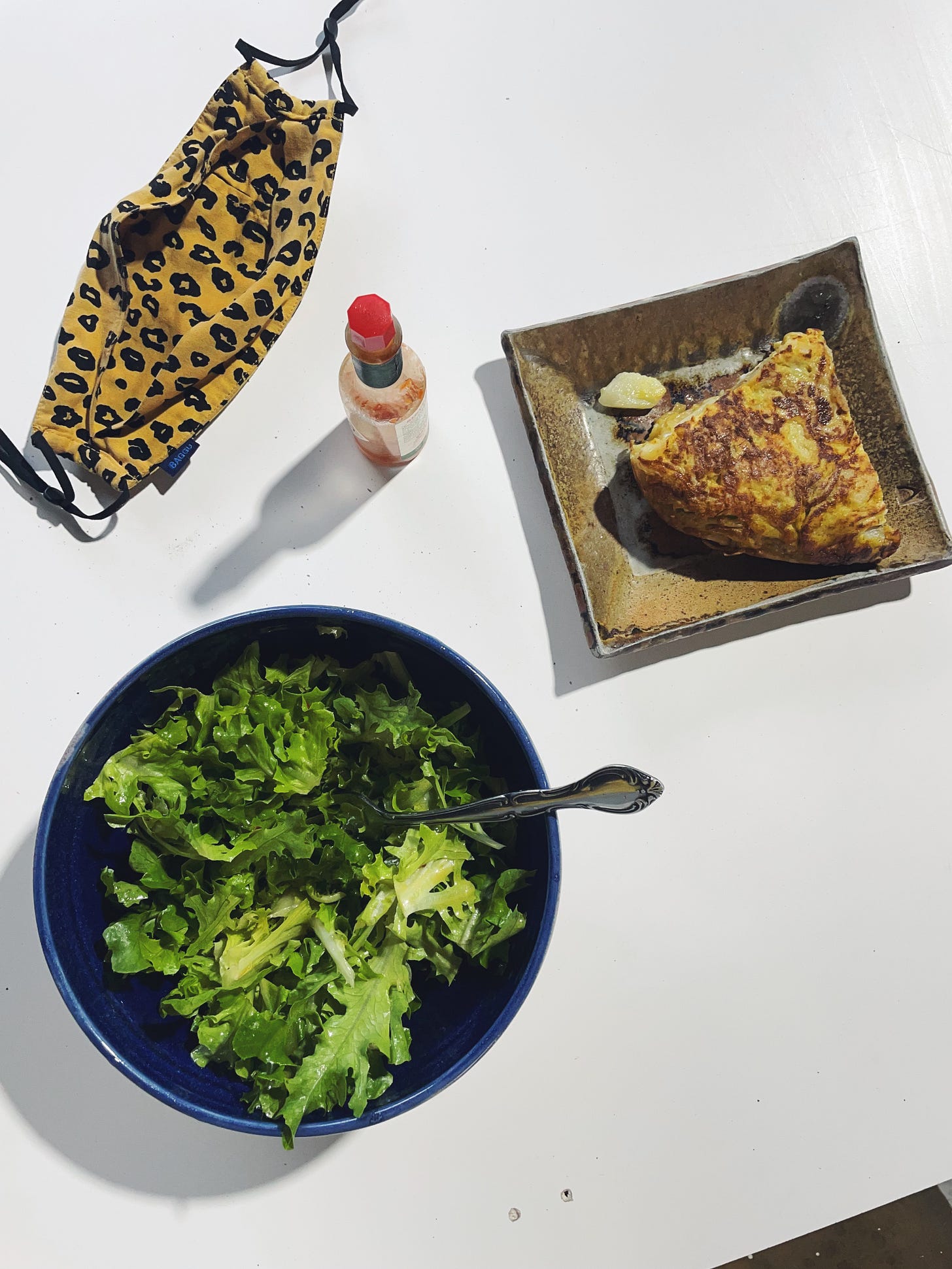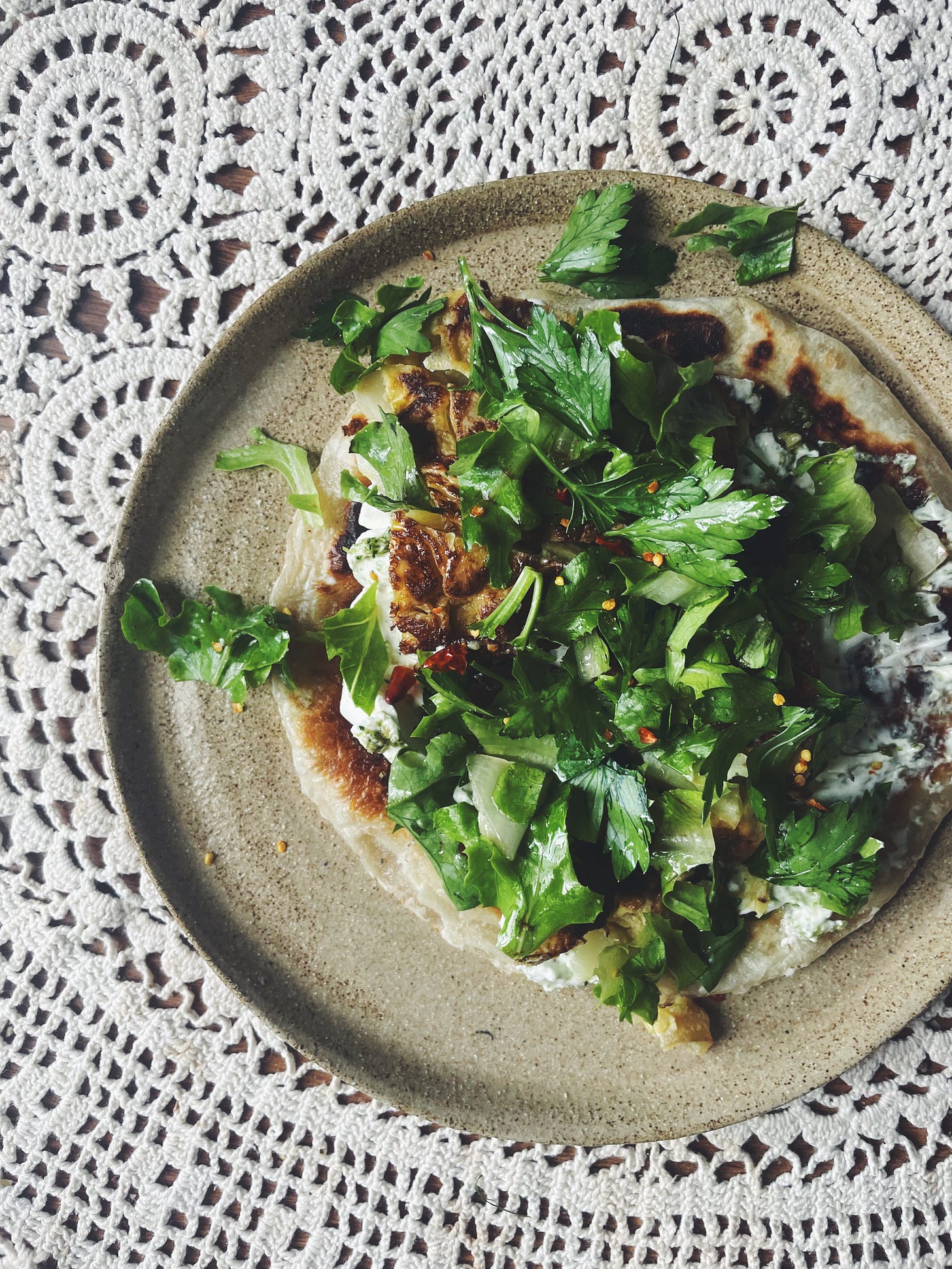For something so simple—an amalgamation of eggs, onions, potatoes, oil, and salt—tortilla de patata is shockingly imposing. In Spain’s bar-cafes, rounds of tortilla sit tall and thick on glass cake plates, ready to be sliced. Their heft is obvious, their skin a yolky yellow traced with ribbons of golden brown that map its time in the pan. In these restaurants tortilla is always an option, whether as a tapa or pintxo or light lunch or the filling of a fat sandwich.
When I was a teenager spending a school year in Spain with a gaggle of other American 16- to 18-year olds, tortilla became a staple, a touchpoint of my days. At the bar across the street from our school, we would have tortilla for breakfast, or for an afternoon snack after school; when we traveled to Madrid and Barcelona and Sevilla we’d buy tortilla sandwiches on the street, enough to feed us for half a day or soak up a long night of vodka Red Bulls. It kept us going; somehow, I never got sick of it.
Did I ever learn to make it that year? Maybe from my host mother, whose Coca Cola-braised chicken wings I still dream about; or from some other authority figure who hoped I’d expand my cultural education past botellón, eating doner kebabs, pretending to know things about Almodóvar, and grinding with local teens on the weekends. If I’ve made it again since 2005, the memory has been subsumed by all other tortilla-eating memories, a blurry blanket of comfort in the back of my head.

Tortilla is often translated as a potato omelet, but to me it’s more similar to a terrine: a cross-section reveals a neat jumble of potato slices, silky and glistening thanks to a long poach in egregious amounts of olive oil, and studded with wisps of onion. The olive oil is the man behind the curtain, invisible but all-powerful. The egg is simply a suspending force, holding things together first and adding eggy richness second.
A good tortilla should still be custardy in the middle. As the chef Alex Raij points out in her cookbook, Basque, Americans fear anything less than a fully cooked egg, but Spaniards welcome a bit of looseness. It’s a simple but intimidating recipe, predicated on a flip. If tortilla is imposing to diners, it can be terrifying to first-time cooks.
As last week’s newsletter went out, I had a pot of potato and onion slices simmering in an ungodly amount of olive oil. This is the benefit of buying in bulk: you do not fear excess. All that writing about oil plus the potatoes growing eyes on my dining table had finally inspired me to reacquaint myself with tortilla.
That glut of oil cooks the potatoes gently—it’s a simmer, not a hard fry—and infuses them with its flavor and slickness. One the vegetables cook, you strain them out and add plenty of salt and beaten eggs, which coat rather than drown them. You’ll reserve that deliciously potatoey oil, as it’s fine to cook with for weeks if it’s stored in the fridge, and we do not waste good oil. Add a splash of it to a frying pan, and the fun begins.
Figuring out how to make tortilla is, in part, about gaining faith in your limbs and understanding your stove’s effect on a pan full of eggs. Once you’ve poured your potato slurry into the greased pan, you cook it until it begins to firm up. Then you flip it decisively onto a large plate and slip it back into the pan to form a puck-like shape that’s cooked on all sides. It is an opportunity to practice your bravery and brazenness in the kitchen. The goal is not perfection; the goal is keeping your dinner off the floor. Ideally you will try it once, and then again, and then you will feel yourself getting better at it, and understanding its alchemy, and you will have learned something new.
I have now made tortilla twice in the past week; I cannot get enough of it. There is muscle memory in eating, too—in easing a fork into a slice of tortilla, in shaking the bottle of hot sauce over it, in picking at the errant chunks of potato left on my plate. I have absorbed the dish back into my life; in turn, it has found new ways to sustain me. My fridge is currently overstuffed but empty of tortilla; I miss it already.
I’ve eaten plain slices of it sprinkled with hot sauce (Frank’s or Tabasco); I’ve gently reheated it in the microwave at my ceramics studio and served it with with some lettuce dressed in mustard vinaigrette, one of the more elegant lunches I’ve eaten on the loading dock. Tortilla is perfectly delicious cold out of the fridge, but it does best at room temperature, where it can soften and relax.
I’ve also begun serving it atop fluffy pan-fried roti paratha, a new heavy hitter in my freezer rotation. I first came up with the idea after coming home tipsy and starving after Clio’s birthday party, always a recipe for culinary innovation. For a Monday dinner party this week, I tested the limits of the combination to great success: everyone got a paratha (fried in ghee), topped with garlic scape pesto and a generous smear of labneh. I cut the tortilla not in wedges but in 1/2-inch slices, so that they could lay like sliced steak atop the flatbread. Then everything got topped with a tomato chutney from the Juhu Beach Club cookbook, crumbled pequín chiles, and parsley dressed in olive oil and sherry vinegar. Humble excess, you might call it. A smash.
It is easy to want to embellish your tortilla while making it—to add other bits and bobs in with the potato and onion. I briefly considered experimenting with nduja, curry leaves, asparagus maybe? In Spain, you’ll often find a tortilla studded with chorizo, which I would never kick out of bed. But at home, I refrain from messing with the formula, and instead pile on top of it. I’d rather gild the lily than reinvent it; nature was right the first time.
Tortilla de Patata
Serves 6-8 as a meal, or more as a snack.
Adapted from Alex Raij, Caroline Fidanza, and Laila Gohar
Keep reading with a 7-day free trial
Subscribe to Mess Hall to keep reading this post and get 7 days of free access to the full post archives.





